Discover Florida Nature
It's time to explore the natural Florida


|
|
|
|
|
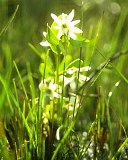 Beautiful
Pawpaw (Deeringothamnus pulchellus)-The pine flatwoods of
Babcock-Webb are home to the largest known population of the very rare
beautiful pawpaw. The beautiful pawpaw is endemic to Charlotte and Lee
counties. Flowering (usually from late March through May) tends to occur
only after a fire or mowing of new growth. The beautiful pawpaw has
fragrant white flowers and a 3-inch long fruit resembling a lumpy bean
pod. The greatest threat to the beautiful pawpaw is destruction of
habitat for residential development. Beautiful
Pawpaw (Deeringothamnus pulchellus)-The pine flatwoods of
Babcock-Webb are home to the largest known population of the very rare
beautiful pawpaw. The beautiful pawpaw is endemic to Charlotte and Lee
counties. Flowering (usually from late March through May) tends to occur
only after a fire or mowing of new growth. The beautiful pawpaw has
fragrant white flowers and a 3-inch long fruit resembling a lumpy bean
pod. The greatest threat to the beautiful pawpaw is destruction of
habitat for residential development.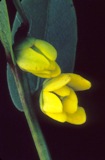 Rugel's
Pawpaw (Deeringothamnus rugelii)- Rugel's pawpaw is a low shrub
with a stout taproot. The fruits are cylindrical berries with pulpy
flesh,1 to 3 inches long, and yellow-green when ripe. Seeds are about
the shape and size of brown beans. The annual or biennial stems are 4 to
8 inches tall, rarely taller. The plant re-sprouts readily from the
roots after the top is destroyed by fire or mowing. The absence of such
disturbance leads to the plant's eventual demise. This pawpaw bears
flowers with straight, oblong, canary yellow petals. Rugel's pawpaw is
presently known primarily from an area near New Smyrna Beach in Volusia
County, Florida. There are presently twenty-nine known populations of
which half are on public lands. The general habitat type for the Rugel's
pawpaw is poorly-drained slash pine-saw palmetto flatwoods. Rugel's
Pawpaw (Deeringothamnus rugelii)- Rugel's pawpaw is a low shrub
with a stout taproot. The fruits are cylindrical berries with pulpy
flesh,1 to 3 inches long, and yellow-green when ripe. Seeds are about
the shape and size of brown beans. The annual or biennial stems are 4 to
8 inches tall, rarely taller. The plant re-sprouts readily from the
roots after the top is destroyed by fire or mowing. The absence of such
disturbance leads to the plant's eventual demise. This pawpaw bears
flowers with straight, oblong, canary yellow petals. Rugel's pawpaw is
presently known primarily from an area near New Smyrna Beach in Volusia
County, Florida. There are presently twenty-nine known populations of
which half are on public lands. The general habitat type for the Rugel's
pawpaw is poorly-drained slash pine-saw palmetto flatwoods. 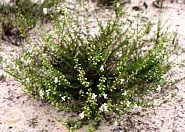 Garrett's
Mint (Dicerandra christmanii)-Garrett's mint is a small
fragrant shrub smelling of eucalyptus. It reaches a height of up to 1.3
feet tall. The stems are square with low ridges. Both stems and leaves,
which are pitted with oil glands, have a strong mint odor. The narrowly
oblong leaves are about 1 inch long, have smooth edges, and grow
opposite each other. The vegetative and flowering branches are stiff as
they rise from the branching woody base. The tap root is also branched
with extensive, spreading, fibrous roots. Blooming in July - November,
the flowers of Garrett's mint, or Garrett's scrub balm as it is
sometimes called, grow in whorls around the square stem with 1 - 3
flowers per whorl. The white or cream colored flowers have purple spots
and lines, are 2-lipped with rounded lobes and have sharply bent tubes.
The stamens have bright yellow anthers that extend beyond the flower.
Garrett's mint is endemic to Florida, and is only found in Highlands
County at this time. Having a extremely small range, all five known
populations are located between Lake Jackson and Lake Istokopga.
Dicerandra christmanii is found within openings in oak scrub habitat. Garrett's
Mint (Dicerandra christmanii)-Garrett's mint is a small
fragrant shrub smelling of eucalyptus. It reaches a height of up to 1.3
feet tall. The stems are square with low ridges. Both stems and leaves,
which are pitted with oil glands, have a strong mint odor. The narrowly
oblong leaves are about 1 inch long, have smooth edges, and grow
opposite each other. The vegetative and flowering branches are stiff as
they rise from the branching woody base. The tap root is also branched
with extensive, spreading, fibrous roots. Blooming in July - November,
the flowers of Garrett's mint, or Garrett's scrub balm as it is
sometimes called, grow in whorls around the square stem with 1 - 3
flowers per whorl. The white or cream colored flowers have purple spots
and lines, are 2-lipped with rounded lobes and have sharply bent tubes.
The stamens have bright yellow anthers that extend beyond the flower.
Garrett's mint is endemic to Florida, and is only found in Highlands
County at this time. Having a extremely small range, all five known
populations are located between Lake Jackson and Lake Istokopga.
Dicerandra christmanii is found within openings in oak scrub habitat.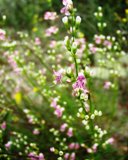 Longspurred
Mint (Dicerandra cornutissima)- Dicerandra cornutissima, or
longspurred mint, is a strongly aromatic plant. It is a short-lived
perennial that grows from seed. It can grow up to 1.6 feet tall with the
erect, non-woody flowering shoots growing from a woody base. The linear
leaves are about 1/2 of in an inch long, covered with conspicuous
glands, and with entire margins. The leaves are borne opposite of one
another, often with two smaller leaves at each node. The purplish-rose
flowers of this species distinguish it from others in the genus, with
deep purple markings, a whitish throat, and a style with few, if any,
hairs. These flowers are borne in groups in the axils of the leaves, and
are usually found on the upper parts of the stems. The two-lipped, 7mm
long petals form a tube which is bent at a 90-degree angle in the
middle. The anthers are tipped by a 1.2 mm long spur, hence the common
name. Longspurred mint flowers in September and produces fruit in the
form of four small nutlets. This species reproduces only from seed.
Longspurred mint grows in the xeric upland habitats of sandhill and
scrub of Marion and Sumter counties. The longspurred mint is found only
in open areas in sand pine scrub or oak scrub, and the ectones between
these and turkey oak communities. It can colonize the edges of road
rights-of-way Longspurred
Mint (Dicerandra cornutissima)- Dicerandra cornutissima, or
longspurred mint, is a strongly aromatic plant. It is a short-lived
perennial that grows from seed. It can grow up to 1.6 feet tall with the
erect, non-woody flowering shoots growing from a woody base. The linear
leaves are about 1/2 of in an inch long, covered with conspicuous
glands, and with entire margins. The leaves are borne opposite of one
another, often with two smaller leaves at each node. The purplish-rose
flowers of this species distinguish it from others in the genus, with
deep purple markings, a whitish throat, and a style with few, if any,
hairs. These flowers are borne in groups in the axils of the leaves, and
are usually found on the upper parts of the stems. The two-lipped, 7mm
long petals form a tube which is bent at a 90-degree angle in the
middle. The anthers are tipped by a 1.2 mm long spur, hence the common
name. Longspurred mint flowers in September and produces fruit in the
form of four small nutlets. This species reproduces only from seed.
Longspurred mint grows in the xeric upland habitats of sandhill and
scrub of Marion and Sumter counties. The longspurred mint is found only
in open areas in sand pine scrub or oak scrub, and the ectones between
these and turkey oak communities. It can colonize the edges of road
rights-of-way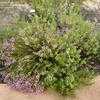 Lakela's
Mint (Dicerandra immaculata)-Lakela's mint is a small,
fragrant, perennial shrub that reaches a height of 50 cm. It was listed
in 1985 as federally threatened, and faces a high risk of extinction
because so much of its habitat has been lost and its populations are so
fragmented. This species is known from only one wild population.
Lakela's mint can be differentiated from others in the Dicerandra genus
by its lavender-rose colored flower that has no spots on it. When grown
in open sun, its growth is bushy; in the shade it becomes lax. The
primary branches arise from a stout, deep, woody-branched taproot. The
flowers which appear primarily September through November, are formed in
whorls of 1 to 3 flowers in the leaf axils. The tiny flowers are less
than 0.8 inches long, rose-purple with no spots or lines. Lakela's mint,
a Florida endemic, is restricted to sand scrub habitats found on ancient
dunes formed along former ocean shorelines in Indian River and St. Lucie
Counties, being confined to a area one-half mile wide by three miles
long. Lakela's
Mint (Dicerandra immaculata)-Lakela's mint is a small,
fragrant, perennial shrub that reaches a height of 50 cm. It was listed
in 1985 as federally threatened, and faces a high risk of extinction
because so much of its habitat has been lost and its populations are so
fragmented. This species is known from only one wild population.
Lakela's mint can be differentiated from others in the Dicerandra genus
by its lavender-rose colored flower that has no spots on it. When grown
in open sun, its growth is bushy; in the shade it becomes lax. The
primary branches arise from a stout, deep, woody-branched taproot. The
flowers which appear primarily September through November, are formed in
whorls of 1 to 3 flowers in the leaf axils. The tiny flowers are less
than 0.8 inches long, rose-purple with no spots or lines. Lakela's mint,
a Florida endemic, is restricted to sand scrub habitats found on ancient
dunes formed along former ocean shorelines in Indian River and St. Lucie
Counties, being confined to a area one-half mile wide by three miles
long.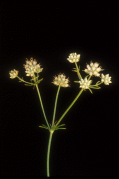 Snakeroot
(Eryngium cuneifolium)- Snakeroot, or Wedgeleaf Eryngium, as it is also
called, is a short-lived herbaceous perennial, with a basal rosette and
flowering scapes. It possesses a deep taproot but rarely re-sprouts
following fire. Perfect, small, greenish flowers (10-15) are borne on
head-like umbels, the heads displayed on a diffusely branching
inflorescence. Wedgeleaf eryngium is endemic to the southern tip of the
Lake Wales Ridge, found only in the southern half of Highlands County.
Plants flower for about a month in late summer or fall, producing seeds
in the fall. Germination occurs in the winter and spring. Although some
seeds can germinate shortly after maturation, most seeds remain dormant
for a year or more, germinating in subsequent winter seasons. Snakeroot
(Eryngium cuneifolium)- Snakeroot, or Wedgeleaf Eryngium, as it is also
called, is a short-lived herbaceous perennial, with a basal rosette and
flowering scapes. It possesses a deep taproot but rarely re-sprouts
following fire. Perfect, small, greenish flowers (10-15) are borne on
head-like umbels, the heads displayed on a diffusely branching
inflorescence. Wedgeleaf eryngium is endemic to the southern tip of the
Lake Wales Ridge, found only in the southern half of Highlands County.
Plants flower for about a month in late summer or fall, producing seeds
in the fall. Germination occurs in the winter and spring. Although some
seeds can germinate shortly after maturation, most seeds remain dormant
for a year or more, germinating in subsequent winter seasons.
|
|
|
Advertise | Privacy Statement | Dog Encyclopedia | Video |Contact | Alaska Nature |
|